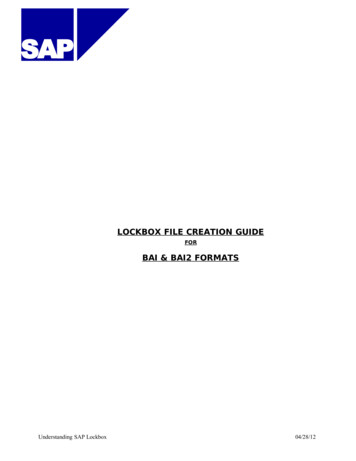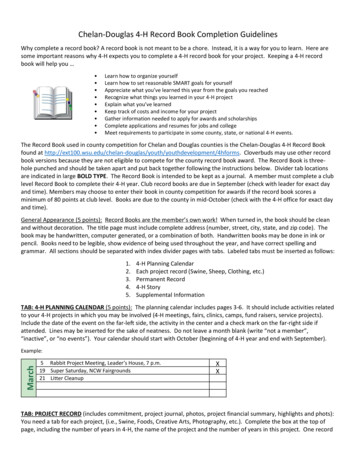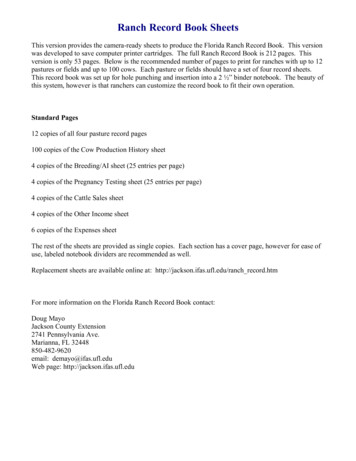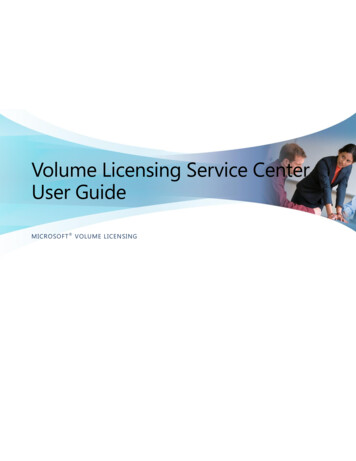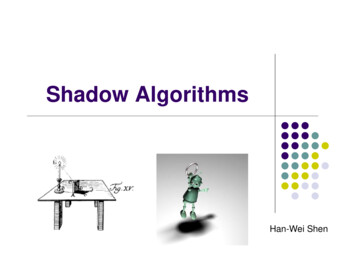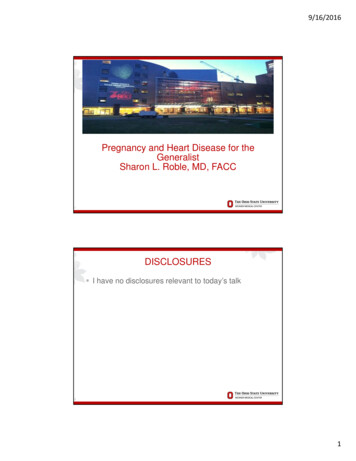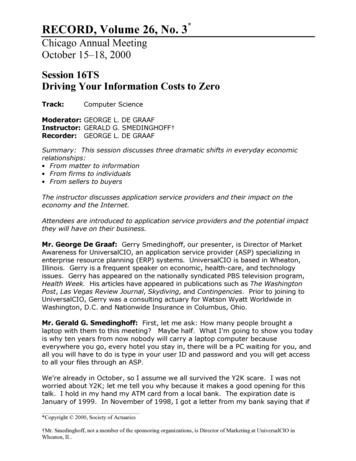
Transcription
RECORD, Volume 26, No. 3*Chicago Annual MeetingOctober 15–18, 2000Session 16TSDriving Your Information Costs to ZeroTrack:Computer ScienceModerator: GEORGE L. DE GRAAFInstructor: GERALD G. SMEDINGHOFF†Recorder: GEORGE L. DE GRAAFSummary: This session discusses three dramatic shifts in everyday economicrelationships: From matter to information From firms to individuals From sellers to buyersThe instructor discusses application service providers and their impact on theeconomy and the Internet.Attendees are introduced to application service providers and the potential impactthey will have on their business.Mr. George De Graaf: Gerry Smedinghoff, our presenter, is Director of MarketAwareness for UniversalCIO, an application service provider (ASP) specializing inenterprise resource planning (ERP) systems. UniversalCIO is based in Wheaton,Illinois. Gerry is a frequent speaker on economic, health-care, and technologyissues. Gerry has appeared on the nationally syndicated PBS television program,Health Week. His articles have appeared in publications such as The WashingtonPost, Las Vegas Review Journal, Skydiving, and Contingencies. Prior to joining toUniversalCIO, Gerry was a consulting actuary for Watson Wyatt Worldwide inWashington, D.C. and Nationwide Insurance in Columbus, Ohio.Mr. Gerald G. Smedinghoff: First, let me ask: How many people brought alaptop with them to this meeting? Maybe half. What I'm going to show you todayis why ten years from now nobody will carry a laptop computer becauseeverywhere you go, every hotel you stay in, there will be a PC waiting for you, andall you will have to do is type in your user ID and password and you will get accessto all your files through an ASP.We're already in October, so I assume we all survived the Y2K scare. I was notworried about Y2K; let me tell you why because it makes a good opening for thistalk. I hold in my hand my ATM card from a local bank. The expiration date isJanuary of 1999. In November of 1998, I got a letter from my bank saying that if*Copyright 2000, Society of Actuaries†Mr. Smedinghoff, not a member of the sponsoring organizations, is Director of Marketing at UniversalCIO inWheaton, IL.
Driving Your Information Costs to Zero2you bring in your ATM card, we will exchange it for a new one. We'll also give you a 95 travel voucher on Continental Airlines. When I first got this letter, I thoughtthis was neat. I'd like a free travel voucher. But I also thought, wait a minute.They've always just sent me new cards whenever my old card expired. When yourcredit card is about to expire, they automatically send you a new one. Why arethey going to the extra expense to give me this travel voucher? More importantlyfrom my perspective, why were they making me go to the bank and exchange thecard?I'm one of those people who never wants to see a bank teller again. So I waspondering this for a while, and then it finally dawned on me after a few weeks whythey wanted me to bring the card back into the bank. The reason, I guessed, wasthat these cards were not Y2K compliant and the expiration dates were not valid.And I bet that the cards would still work after January 1999. So I simply waiteduntil February 1999, went to the bank, put my ATM card in, and got 300 cash. Istill have not gone in to exchange my card. This is a withdrawal receipt from lastFriday. So it still works 20 months after the expiration date. The important partof this story is, this bank saw that it had a Y2K problem well in advance. And ratherthan looking at it as a Y2K problem, they looked at it as a marketing opportunity tocement the relationship with their customers.Our clients are manufacturers and suppliers to the auto industry and they makethings—as they say in economics—that you can drop on your foot, as opposed tothe realm of insurance that most of you deal with. This talk actually has a moreurgent implication to the insurance world because I'm talking about pureinformation and that's pretty much the only product that you sell.There have been 5 major economic shifts over the last 20 years. The first majorshift is from matter to information. People now realize that the value of theinformation about a company exceeds the value of its tangible assets. This wasfirst brought to light back in the early 1980s when some accountant at AmericanAirlines noticed that the market value for their SABRE Reservation Systemexceeded the value of all the planes in the American Airlines fleet.As we moved into the 1980s, more examples of this started to pop up. In the late1980s, TV Guide was sold to Rupert Murdock for something like 1 billion. At thattime, 1 billion was worth more than the market value of either ABC, CBS, or NBC.So the value of the information about what was on television exceeded the value oftelevision itself. Now we've gone to absurd extremes. We've got Amazon.com,which has a market cap that's bigger than Sears and the entire book publishing,distribution, and retailing industry combined. Yet Amazon doesn't even carry anyinventory. You could say that Amazon doesn't sell books. They're sellinginformation about books. Or they're selling information about information.An example you can all relate to is the data on your laptop PC. If your laptop waslost or stolen, what would be your greater concern? Would it be spending 2,000or 3,000 to buy a new laptop, or would it be the value of the lost data that youhad on that hard drive?
Driving Your Information Costs to Zero3The second shift is from firms to individuals. We now have situations where peoplehave greater access to information in their personal lives than on the job. I'velisted 6 examples of information technology (IT) devices that have been introducedover the last 20 years: e-mail, cell phone, Internet, voice mail, fax, and the pager.I bet most of you are like me in that you have had access to one or more of thesedevices in your personal life before you had access to them on the job. In mycase, I had access to all of them, except the pager, in my personal life before I hadaccess to it in my business life. That can make things very complicated or veryawkward, because now you're more productive at home than you are at work,especially in the information business. You almost have to ask yourself, "Whyshould I bother to go to work because I have greater access to technology tools athome than I do in the office?" You also have to ask yourself, "What's going tohappen when my customers have better access to information than my employeesdo?" How are they going to interact with your company?The third shift is from sellers to buyers. I'm sure you've all had the sameexperience that I've had — it might be with a grocery store or with a hardwarestore. With me it was with a bookstore. You go into the store that you've beengoing to for several years, you can't find something, and you ask somebody whoworks there, "Do you know where this is?" And right after the person starts tolook for what you ask for, you realize he or she knows less about the store thanyou do. They're not going to find it. Why is this the case? The reason is, you'vebeen living there for five, seven, or ten years. You've been going to the store allthat time. This person they just hired has only been there two or three weeks.You have spent more time in that store than he or she has. You know the layoutand the products of the store better than he or she does. In many ways thatperson is getting in the way—keeping you from getting the products and servicesthat you want. In many cases you're shopping in a store that doesn't have whatyou want. It's understaffed with untrained employees. You have to go back to thestore a second time to get your special order. And you have to pay more to coverthe extra overhead.The fourth shift is a shift from private to public. In the last 20 years, wealth hasbeen created by sharing information, not hoarding it. Systems are now openinstead of closed. Two classic examples from the late 1970s are Apple, whichthought it owned the entire concept of the personal computer, and Sony, whichthought it owned the entire concept of the VCR. They thought, "We are going toown the entire box, the entire concept. If anybody wants to watch a program onvideocassette, they have to buy a Sony Betamax." Apple thought the same thingwith personal computers. They had a closed system; they wouldn't sell theirtechnology. What market share does Apple have today? What market share doesthe Sony Betamax have today?Information must be shared instead of kept secret. You have to share yourbusiness strategy and your data. I still run into people who say, "I've got this ideafor a business, but I can't tell you about it; it's secret." Well, if your business plan isgoing to work, not only do you have to tell your investors, you also have to tell the
Driving Your Information Costs to Zero4public. If you don't tell the public, the customer is not going to know that it exists;they're not going to want to buy it.It's the same with your data. Our clients are manufacturers, and they're verysecretive, as I'm sure you probably are with your data. A manufacturer says, "Wecan't let anybody know what our production schedule is." Well, if your vendorsdon't know what your production schedule is, how can they ship you the materialsyou need on time? And if your customers don't know what your productionschedule is, how can they know what's in your inventory? How do they knowwhether or not you can meet their needs? If somebody shares their informationand you don't, guess which company the customer is going to go to.Things have to be simple instead of complex. We can all identify with this withVCRs. We'd much rather have a VCR which is simple and easy to use instead of aVCR with a lot of features that are too complicated to understand. In the world ofERP, there is SAP, a software company out of Germany. They have what somepeople regard as the best ERP software in the business. The problem is, it's themost complicated, the most difficult to learn, and the most difficult to run. Youmay have heard that Hershey Candy, which recently installed this SAP software,was unable to ship candy to their customers for the Halloween season becausethey couldn't get their software to work.We're moving toward standards as opposed to things that are unique. Forexample, when you get into a rental car, one thing you know is that the gas pedalis always going to be on the right and the brake pedal is always going to be on theleft; the turn signal is going to be roughly in the same place, as are the wipers. Thisis the advantage of the Internet. It's a single standard; everybody communicateson the same platform.The biggest shift is from ownership to assets. Ownership of physical resources isnow a liability instead of an asset. The classic example here is Chrysler in the late1970s when it was on the brink of bankruptcy. Chrysler was making lots of carsthey couldn't sell. So they stored them in vacant parking lots. By Chrysler'saccounting, these cars were assets. Well, those cars were actually a liability theycouldn't sell; they couldn't turn them into cash and Chrysler almost went out ofbusiness.We are moving from a transaction-based economy to a relationship-basedeconomy. Classic examples here are somebody trying to sell you a used car or acar that's a lemon. The idea was, if I could tell you lots of lies or shade the truthenough and sucker you into buying this car, I could take your check and run awayfrom you where you can't find me. You could say the same thing about the wholelife insurance policies from years back when the agent would do anything he or shecould to get you to put some money down for a whole life insurance policy.Instead of just buying a new car from a dealer today, we now have a relationshipwith a new car dealer. All cars come with a three-year bumper-to-bumperwarranty. So anytime you buy or sell something, you're entering into a long-termrelationship.
Driving Your Information Costs to Zero5Since we're entering into long-term relationships, we don't really have to ownthings anymore. We're finding that we're leasing things instead of buying them.We're leasing cars and computers these days. You don't have to own an asset touse it. A perfect example is airplanes. You don't have to own a plane to be able tofly coast-to-coast. Companies don't have to look so much at capital expensesanymore. They don't have to put down a huge amount of money, like when youbuy a car or a home mortgage. They don't have to buy assets; they just have tolease them to use them.Also, you don't need to own the whole thing. We're moving from a whole conceptto just an interchangeable parts concept. Dell is the perfect example withcomputers. Dell does not make, to my knowledge, any of these components thatgo into their personal computers. They purchase disk drives from Seagate, theyget monitors from Sony, and they get modems from U.S. Robotics. All these havea plug-and-play interaction; if one part doesn't work, they can swap it out andeither get a replacement or a part from another manufacturer.Remember the title of my talk is "Driving Your Information Costs to Zero." Let medefine information costs or define where we're going. If you read the businesspress or the economics literature these days, one name that's popping up moreand more is an economist named Ronald Coase. In 1991 Coase was awarded theNobel Prize in economics for his work on information costs back in the 1930s.Ronald Coase's key insight was that the purpose of a firm or a business is toreduce information costs. I'll explain this a little bit more later, but for now thinkabout information costs as the make-or-buy decision.An excellent example is a company cafeteria. When you go back 30 or 40 years,companies that had large facilities would own the company cafeteria. The peoplewho worked in the cafeteria worked for the company—say Ford or a big insurancecompany. Well, we all know from 30 or 40 years ago, the food was lousy and thecafeteria operated at a loss. The reason was Ford is not in the food business; Forddoesn't know anything about food. If you go to a company cafeteria today, you'llnotice that the company does not own the cafeteria. That cafeteria is an outsidecontractor. It's the same thing with a travel agency. Companies used to havetheir own travel agencies in-house; now most of that is done outside.This also works on the opposite extreme. Take something we all know how to dolike change our oil or bake a loaf of bread. These things are very easy to do, butvirtually none of us does them because our time is too valuable to be spent ontime-consuming mundane tasks.The other key economic insight came from J. L. Kelly, who published a veryobscure article in the Bell Systems Technical Journal back in 1956. His article wasessentially a mathematical proof which showed that wealth is created as more datais transmitted with fewer errors over the same unit of time. I like to call this theinformation principle. This is a corollary to what you could call the productionprinciple—that wealth is created as more goods are manufactured and shipped with
Driving Your Information Costs to Zero6fewer defects over the same unit of time. What Kelly showed is that wealth isdirectly related to transmission speed. Like your Internet connection: the faster thebetter. And your wealth is inversely related to your error rate. The error rate incommunication would be like noise, static on a phone line, or it could bebackground noise if there was somebody operating a jackhammer outside.Prior to 1850, in the agricultural era, the limiting economic factor was inventory orraw materials. People were scrounging the earth looking for enough food andwater to survive. That's why nations and tribes went to war—they went to warover raw materials. Once we entered the industrial era, the limiting economicfactor became unskilled labor. The barons of the industrial era such as AndrewCarnegie, Cornelius Vanderbilt, and Henry Ford weren't hunting for raw materials;they were hunting for warm bodies to man the machines in their factories.Once you get into the post-World War II era, the limiting economic factor wasskilled labor. Warm bodies were no longer good enough to get the job done.You've probably all seen those pictures from the Great Depression with a line ofmen waiting outside a factory gate. The foreman would open the gate and hire thenext 30 guys who walked in. You'll notice there aren't many companies that hirelabor on that principle today. Or if there are, they're not listed on the New YorkStock Exchange.When you move into the 1970s and 1980s, the limiting economic factor becamefinancial capital. Call this internal data, or information about the company. The keyinnovator here was Michael Milken, the so-called junk bond king. Milken's keyinsight was that the value of a company was not the traditional model of adding upthe values of all the plants, equipment, and inventory. He said the value of acompany is the discounted cash flow of the future revenue streams. There are twoaspects here. First, Milken says we're going to value a company based oninformation, not physical assets. And second, we're going to value a companybased on the future instead of looking at what it's done in the past.As you move into the 1990s, the limiting economic factor became communication.Data is valuable, but if you keep data to yourself, you're essentially squashing it orsuffocating it. To make data valuable, you have to share it. You have to share itwith your vendors; you have to share it with your employees; you have to share itwith your customers; you have to share it with the public.As we move into the 21st century, the limiting economic factor is bandwidth. Thinkof this as the speed of your Internet connection. It's how fast you can shove datadown a pipeline. And the good news here is that most of the experts predict thatby the year 2010, bandwidth will no longer be a factor; we'll be able to buy asmuch as we want.Let's relate this to the history of your management information services (MIS)department or your IT department. If you go back into the 1960s, MIS was almostconsidered to be a division of a company. The reason MIS was a division wasbecause those million dollar monster IBM mainframes represented such a huge
Driving Your Information Costs to Zero7portion of a company's assets. In the 1960s we were obsessed with economies ofscale and the idea that bigger was better. Next year we're going to buy an evenbigger mainframe. Well, in the 1970s, just the opposite happened. All of a suddenthe innovation in computer technology moved away from bigger is better. The1970s was the era of the minicomputers from DEC and Control Data.As computers started to get smaller in the 1970s, so did the importance of MIS.The MIS function of a company was now viewed as a department or a team ofpeople with shared skills. As you move into the 1980s, along comes the personalcomputer. Now we all have PCs on our desks. Well, if everybody has a computeron their desk, what happens to MIS? MIS goes where the computers are. So MISwas broken up and reported to the various different functions: accounting, finance,manufacturing, payroll, or whatever it was. IT people were now looked on astechnicians who had a specific knowledge.As they moved into the 1990s, companies started to outsource their IT. They said,"Look, we have all of these computers sitting on our property, but we can't hire thepeople to run them." So they started to bring in consultants to run their ITdepartment. As we move into the 21st century, the outsourcing is going to becomplete. Companies are going to look at their computer systems and say, "Whydo we have these computers? We don't know anything about computers. Whydon't you, the ASP, take our computers and put them on your property where yourpeople are, because you know more about computers than we do, and we will justaccess our soft
The fourth shift is a shift from private to public. In the last 20 years, wealth has been created by sharing information, not hoarding it. Systems are now open instead of closed. Two classic examples from the late 1970s are Apple, which . ERP, there is SAP, a software

